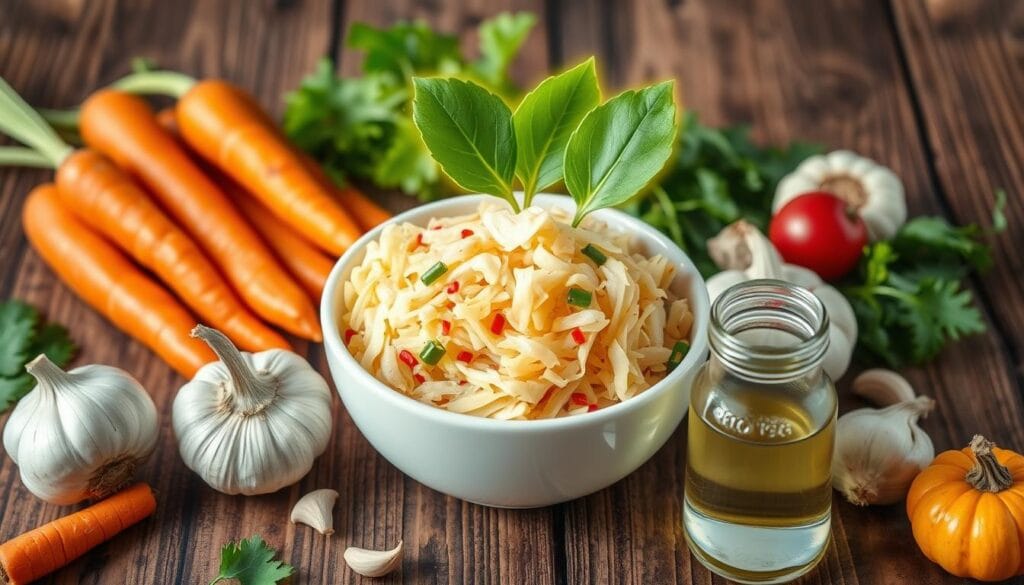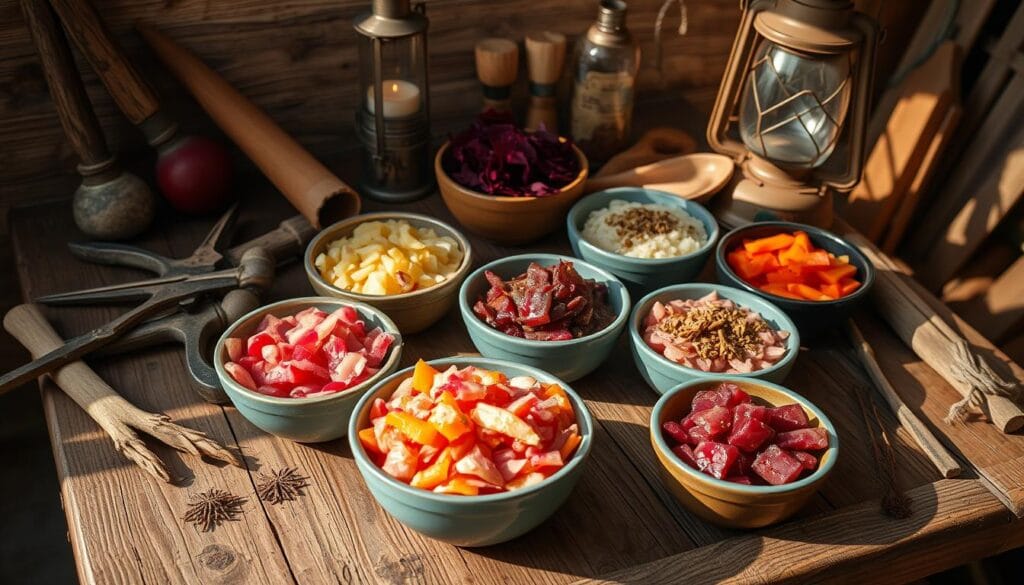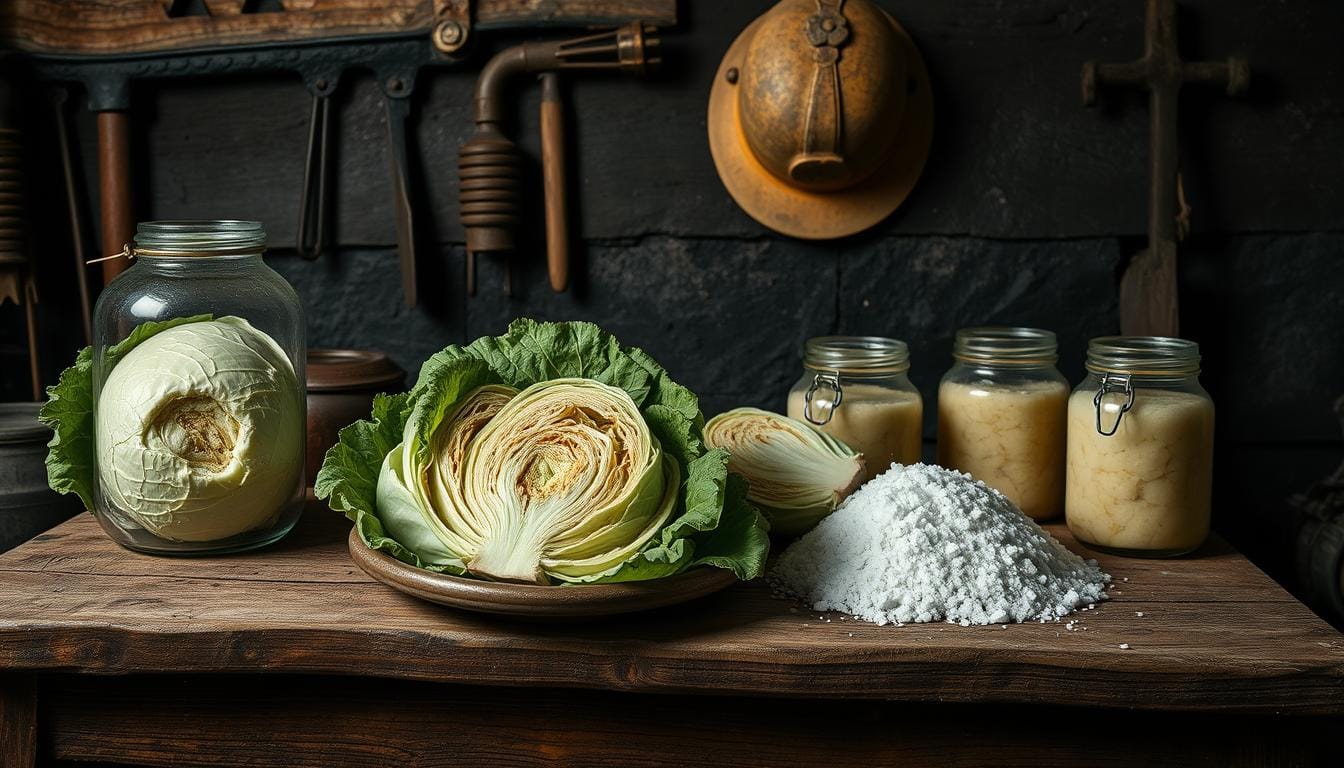The coal miner’s recipe for sauerkraut is a traditional and tasty way to keep cabbage fresh. It’s one of the top recipes for sauerkraut. Passed down for generations, it uses simple fermentation to preserve cabbage. This dish is not only delicious but also full of health benefits, making it a great side dish for any meal.
This recipe shows the resourcefulness and cooking skills of coal miners. It was a staple in their diet. By making this dish, you can enjoy a healthy and tasty side dish for any event. This article will guide you through the coal miner’s recipe for sauerkraut, its cultural significance, and how to make it.
Key Takeaways
- Coal miner’s recipe for sauerkraut is a traditional and delicious way to preserve cabbage
- This recipe is considered one of the best coal miner’s recipe for sauerkraut due to its simplicity and effectiveness
- The coal miner’s recipe for sauerkraut is packed with health benefits, making it a great addition to any meal
- The recipe has been passed down through generations, and its uniqueness lies in the simple yet effective method of fermentation
- The best coal miner’s recipe for sauerkraut is a testament to the resourcefulness and culinary skills of coal miners
- By following this traditional recipe, you can create a delicious and healthy side dish that’s perfect for any occasion
Introduction to Coal Miner’s Sauerkraut
Sauerkraut has a long sauerkraut history that goes back centuries to ancient Europe. It was a key food in many cultures, mainly in Eastern Europe. It was valued for its nutrients and taste.
In coal mining areas, sauerkraut was vital. It gave miners essential vitamins and minerals. This was because they often didn’t have access to fresh food.
The coal miner’s recipe for sauerkraut came from European traditions. Immigrant miners brought these recipes with them. Sauerkraut was not just food; it was a way to keep cabbage and veggies fresh in winter.
What is Sauerkraut?
Sauerkraut is fermented cabbage. It’s made by letting cabbage’s natural bacteria break down sugars. This makes it sour and crunchy.
The coal miner’s recipe for sauerkraut involves shredding cabbage, salting it, and fermenting it. This process gives it its unique taste and texture.
The Historical Context
The story of sauerkraut is linked to coal mining in Europe and America. Miners moved to new places, taking their recipes with them. The sauerkraut history shows the hard work and determination of mining communities.
Ingredients Needed for the Recipe
To make the coal miner’s recipe for sauerkraut, you’ll need the best ingredients. The quality of these ingredients will affect the taste and texture of your sauerkraut.
Essential Ingredients
The key ingredients are shredded cabbage, salt, and caraway seeds. These form the base of the sauerkraut’s flavor and texture.
Optional Additions
You can also add garlic, onions, and apples to the recipe. These ingredients enhance the sauerkraut’s flavor.
Sourcing Quality Ingredients
Choose fresh, high-quality produce for your ingredients. The best sauerkraut comes from ingredients without pesticides. Buy from local farmers or use organic produce for the best taste and texture.
Using the best ingredients and following the coal miner’s recipe will give you a tasty and healthy side dish. It’s perfect for any meal.
| Ingredient | Quantity |
|---|---|
| Shredded Cabbage | 5 lbs |
| Salt | 1 tbsp |
| Caraway Seeds | 1 tsp |
Health Benefits of Sauerkraut
Sauerkraut is packed with nutrients, making it great for a healthy diet. It’s full of vitamins, minerals, and antioxidants. It also supports your digestive health with probiotics.
Some of the key health benefits of sauerkraut include:
- High in vitamins and minerals, such as vitamin C and potassium
- Rich in antioxidants, which help protect against cell damage
- Contains probiotics, which support digestive health and boost the immune system
- May help reduce inflammation and improve symptoms of certain health conditions
The nutritional value of sauerkraut is key to its health benefits. It’s a good source of fiber, which aids digestion and keeps blood sugar levels healthy. The probiotics in sauerkraut are vital for a healthy gut and a strong immune system.

Adding sauerkraut to your meals can greatly improve your health. Its rich nutrition and many health benefits make it a great choice for salads, sandwiches, soups, and stews.
| Nutrient | Amount per serving |
|---|---|
| Vitamin C | 25% of the Daily Value (DV) |
| Potassium | 15% of the DV |
| Fiber | 10% of the DV |
The Traditional Fermentation Process
Traditional sauerkraut fermentation is an art that needs patience and detail. It involves steps to create the right conditions for beneficial bacteria to grow.
The first step is preparing the cabbage. This means shredding or cutting it into thin strips. This action releases juices and increases the surface area for bacteria.
Preparing the Cabbage
To start, remove the outer leaves and wash the cabbage under cold water. Then, cut or shred it into thin strips, based on your preference.
Salting the Cabbage
Salting the cabbage is key. Salt creates an environment that’s bad for harmful bacteria but good for beneficial ones.
Fermentation Time and Conditions
The time and conditions for fermentation vary. They depend on temperature, humidity, and cabbage type. Fermentation can take days to weeks.
Here’s a quick overview of the fermentation process:
| Step | Description | Time |
|---|---|---|
| Preparing the Cabbage | Shredding or cutting the cabbage into thin strips | 30 minutes |
| Salting the Cabbage | Adding salt to the cabbage to create an unfavorable environment for harmful bacteria | 30 minutes |
| Fermentation | Allowing the cabbage to ferment under the right conditions | Several days to weeks |
Tips for Perfect Fermented Sauerkraut
To make perfect sauerkraut, follow some key tips. First, choose a clean, wide-mouthed container. This makes it easy to check on the fermentation.
Keeping the right temperature is also important. Aim for 64°F to 75°F. Make sure the sauerkraut is not near sunlight or heat.
Checking the Fermentation Progress
It’s important to check on the fermentation often. Taste the sauerkraut and feel its texture. If it’s too salty or sour, adjust the recipe.
More tips include using the right salt and keeping the sauerkraut covered. Be patient, as fermentation can take weeks. By following these tips, you’ll get delicious sauerkraut for snacking, cooking, or sharing.
Variations on the Classic Recipe
The classic sauerkraut recipe is very versatile. You can make many different sauerkraut recipes by just changing a few things. This lets you add your own flavor or try new ingredients.
One way to vary sauerkraut is by adding different vegetables. Carrots or beets can add color and texture. You can also spice it up with caraway seeds or dill for a unique taste.
Adding Vegetables
Adding vegetables is a great way to make new sauerkraut recipes. Here are some ideas:
- Carrots: shredded or grated carrots add a sweet and crunchy texture
- Beets: pickled beets add a beautiful pink color and a sweet, earthy flavor
- Onions: thinly sliced or caramelized onions add a depth of flavor and a hint of sweetness
Flavoring with Spices
Spices can also change up your sauerkraut recipe. Here are some options:
- Caraway seeds: add a nutty, slightly bitter flavor
- Dill: adds a bright, fresh flavor
- Garlic: minced or crushed garlic adds a pungent flavor

Different Types of Cabbage
Using different cabbage types can also make new sauerkraut recipes. Here are some options:
| Type of Cabbage | Description |
|---|---|
| Green Cabbage | the most commonly used type of cabbage, with a mild flavor and crunchy texture |
| Red Cabbage | a sweeter and more flavorful type of cabbage, with a beautiful purple color |
| Savoy Cabbage | a type of cabbage with a milder flavor and a more delicate texture |
Recipes Inspired by Coal Miner’s Sauerkraut
Sauerkraut is a versatile ingredient that can be used in many dishes. It adds a tangy flavor and has health benefits. If you’re looking for recipes using sauerkraut, there are many options.
Sauerkraut Soup
Sauerkraut soup is a hearty and comforting dish. It’s made with sauerkraut, vegetables, and sometimes sausage or bacon. It’s a delicious and satisfying meal.
Sauerkraut and Sausage
Pairing sauerkraut with sausage makes for a quick and easy dinner. This classic combination is popular in German and Eastern European cuisines. It can be served with potatoes or bread.
Sauerkraut Side Dishes
Sauerkraut can also be used as a side dish. It adds a tangy and refreshing flavor to any meal. Some popular sauerkraut recipe ideas include sauerkraut salad, sauerkraut and bean salad, and sauerkraut coleslaw.
Here are some popular sauerkraut recipes:
- Sauerkraut and sausage skillet
- Sauerkraut and potato soup
- Sauerkraut salad with caraway seeds
With these recipes using sauerkraut, you can add variety to your meals. You’ll enjoy the delicious flavor and health benefits of sauerkraut.
| Recipe | Ingredients | Prep Time |
|---|---|---|
| Sauerkraut Soup | Sauerkraut, vegetables, sausage or bacon | 30 minutes |
| Sauerkraut and Sausage | Sauerkraut, sausage, potatoes or bread | 20 minutes |
| Sauerkraut Salad | Sauerkraut, caraway seeds, vegetables | 15 minutes |
Common Mistakes to Avoid
Making sauerkraut can be tricky. Knowing the common mistakes helps you make it better and safer. With a bit of knowledge, you can avoid these errors and enjoy tasty, healthy sauerkraut.
Over-Salting
One big mistake is adding too much salt. This can make your sauerkraut taste bad and feel wrong in your mouth. To fix this, use the right amount of salt and check the taste often while it ferments.
Insufficient Temperature Control
Not controlling the temperature right can mess up your sauerkraut. Avoid fermenting it too hot or too cold. This can ruin the taste and texture.
Ignoring Hygiene Practices
Not keeping things clean is a big no-no. It can make your sauerkraut go bad. Always use clean tools and follow good storage and handling tips to keep your sauerkraut safe and tasty.
Some common mistakes to watch out for include:
- Using contaminated equipment or ingredients
- Not monitoring the fermentation temperature
- Not storing the sauerkraut properly
Knowing these common mistakes helps you make better sauerkraut. You can avoid these errors and enjoy delicious, healthy sauerkraut.
Storing Your Sauerkraut
To keep your homemade sauerkraut fresh and tasty, follow key storing tips. Use the right containers, keep it cool, and watch the fermentation. This way, you can enjoy it longer and get the most health benefits.
Best Storage Practices
Store sauerkraut in a cool, dark spot. A pantry or cupboard works well, away from sunlight and heat. Use glass jars or containers with tight lids. Press down the cabbage to remove air, preventing mold and spoilage.
Shelf Life and Preservation
Sauerkraut’s shelf life varies based on storage and fermentation level. It can last months when stored right. To keep it longer, refrigerate or freeze it. Freezing is great for preserving flavor and nutrients, using airtight containers or bags.
Freezing Sauerkraut
Freezing sauerkraut is easy and keeps it fresh all year. Here’s how to freeze it:
- Portion the sauerkraut into airtight containers or freezer bags
- Press down the cabbage firmly to remove any air pockets
- Label the containers or bags with the date and contents
- Store the containers or bags in the freezer at 0°F (-18°C) or below
By following these steps, you can enjoy your homemade sauerkraut for a longer time.
| Storage Method | Shelf Life | Benefits |
|---|---|---|
| Refrigeration | Several months | Easy to implement, maintains flavor and texture |
| Freezing | Up to 1 year | Preserves nutritional value, convenient for meal planning |
Enjoying Sauerkraut Beyond the Kitchen
Sauerkraut is more than just a side dish. It’s a key ingredient in many recipes, from traditional German dishes to modern creations. Its tangy flavor and crunchy texture enhance any meal. It’s perfect for salads, sandwiches, and soups.
In mining communities, sauerkraut holds a special place. It’s a staple at community events and festivals. Paired with local foods like sausage and potatoes, it brings people together.
Creative Uses in Meals
- Add sauerkraut to your favorite salad recipe for a tangy twist
- Use sauerkraut as a topping for hot dogs or sausages
- Mix sauerkraut into your favorite soup or stew for added flavor
Cultural Significance in Mining Communities
Sauerkraut has been a part of mining communities for years. It’s often served as a side dish or used in traditional recipes. Its importance shows the community’s rich history and heritage.
Pairing Sauerkraut with Drinks
Sauerkraut goes well with many drinks, from beer to juice. Its tangy taste pairs well with beer’s richness. Its crunchiness complements the sweetness of juice. Here are some popular pairings:
| Drink | Pairing Options |
|---|---|
| Beer | Lager, Pilsner, or Wheat Beer |
| Juice | Apple, Grapefruit, or Cranberry Juice |
Whether you use sauerkraut in meals or enjoy it as a snack, it’s a great choice. Its cultural significance and versatility make it a valuable addition to any diet.
Conclusion: Embracing Tradition and Flavor
As we wrap up our look at the coal miner’s recipe for sauerkraut, it’s clear this dish is more than just food. It’s packed with health benefits, like probiotics and immune-boosting properties. This traditional sauerkraut recipe shows the strength and creativity of coal miners, who kept themselves fed in tough times.
We invite you to try making this sauerkraut at home. It’s a way to connect with our heritage and enjoy delicious flavors. Food can unite us, celebrate our differences, and honor our shared histories.
So, start your tasty adventure today. Make your own coal miner’s recipe for sauerkraut and see how it can make your meals and life better. Enjoy your meal!

